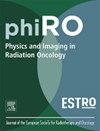磁共振引导下低分割放射治疗头颈癌患者的定量磁共振成像反应。
IF 3.4
Q2 ONCOLOGY
引用次数: 0
摘要
背景与目的:定量磁共振成像(qMRI)在头颈部鳞状细胞癌(HNSCC)放射治疗(RT)过程中检测肿瘤变化的应用已被探索。临床试验显示PD-1靶向免疫检查点抑制可延长生存期。目前正在研究低分割辐射方案,以抵消辐射耐药克隆原的形成。本研究旨在在这些治疗中使用每日qMRI监测。本探索性研究的目的是在一项剂量递增的低分割适应性放疗(DEHART)的I期试验中,探讨qMRI是否可以检测低分割放疗期间肿瘤微环境的变化。材料和方法:17名晚期HNSCC患者接受mr引导下的RT,每日qMRI,使用15份方案,累积剂量为50、55或60 Gy。1.5 T MRI-Linac收集每日体素内非相干运动(IVIM), T1和T2映射。以棘旁肌为对照,计算原发肿瘤中位ADC、D、D*、f、T1和T2。采用线性混合效应模型和非参数检验分析治疗条件和治疗时间对qMRI参数的影响。结论:每日qMRI可有效监测肿瘤在短时间和不同治疗条件下的反应。每日qMRI数据收集有助于进一步研究HNSCC的放射和全身联合治疗。本文章由计算机程序翻译,如有差异,请以英文原文为准。
Quantitative magnetic resonance imaging responses in head and neck cancer patients treated with magnetic resonance-guided hypofractionated radiation therapy
Background and purpose
Quantitative MRI (qMRI) has been explored for detecting tumor changes during radiation therapy (RT) in head and neck squamous cell cancer (HNSCC). Clinical trials show prolonged survival with PD-1 targeted immune checkpoint inhibition. Hypofractionated radiation regimens are being studied to counteract radioresistant clonogen formation. This study aims to use daily qMRI monitoring in these therapies. The objective of this exploratory study was to investigate if qMRI can detect tumor microenvironment changes during hypofractionated RT in a phase I trial of Dose-Escalated Hypofractionated Adaptive Radiotherapy (DEHART).
Materials and methods
Seventeen subjects with advanced HNSCC underwent MR-guided RT with daily qMRI using a 15-fraction regimen to a cumulative dose of 50, 55, or 60 Gy. A 1.5 T MRI-Linac collected daily intravoxel incoherent motion (IVIM), T1, and T2 mappings. Median primary tumor ADC, D, D*, f, T1, and T2 were calculated, using paraspinal muscle as a control. qMRI parameters were analyzed by treatment condition and length using linear mixed effect models and nonparametric tests.
Results
Significant (p < 0.05) increases in ADC, D, f, and T2 were observed over treatment duration for multiple conditions. Daily monitoring enhanced result significance compared to weekly collection.
Conclusions
Daily qMRI effectively monitors tumor response over short periods and varying treatment conditions. Further studies on radiation and systemic therapy combinations in HNSCC could benefit from daily qMRI data collection.
求助全文
通过发布文献求助,成功后即可免费获取论文全文。
去求助
来源期刊

Physics and Imaging in Radiation Oncology
Physics and Astronomy-Radiation
CiteScore
5.30
自引率
18.90%
发文量
93
审稿时长
6 weeks
 求助内容:
求助内容: 应助结果提醒方式:
应助结果提醒方式:


